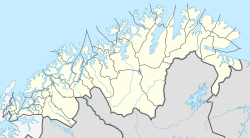Kautokeino (village)
Guovdageaidnu (Northern Sami)
Kautokeino (Norwegian) | |
|---|---|
Village | |
 View of the village | |
 Kautokeino Location in Troms og Finnmark | |
| Coordinates: 69°00′44″N 23°02′27″E / 69.01222°N 23.04083°ECoordinates: 69°00′44″N 23°02′27″E / 69.01222°N 23.04083°E | |
| Country | Norway |
| Region | Northern Norway |
| County | Troms og Finnmark |
| District | |
| Municipality | Kautokeino |
| Area | |
| • Total | 2.45 km2 (0.95 sq mi) |
| Elevation | 319 m (1,047 ft) |
| Population (2017)[1] | |
| • Total | 1,445 |
| • Density | 590/km2 (1,500/sq mi) |
| Time zone | UTC+01:00 (CET) |
| • Summer (DST) | UTC+02:00 (CEST) |
| Post Code | 9520 Kautokeino |
![]() Kautokeino (Northern Sami: Guovdageaidnu) is the administrative centre of Kautokeino Municipality in Troms og Finnmark county, Norway. The village is located along the river Kautokeinoelva, about 60 kilometres (37 mi) south of the village of Masi and about 40 kilometres (25 mi) north of the Finland–Norway border.[3]
Kautokeino (Northern Sami: Guovdageaidnu) is the administrative centre of Kautokeino Municipality in Troms og Finnmark county, Norway. The village is located along the river Kautokeinoelva, about 60 kilometres (37 mi) south of the village of Masi and about 40 kilometres (25 mi) north of the Finland–Norway border.[3]
The 2.45-square-kilometre (610-acre) village has a population (2017) of 1,445 which gives the village a population density of 590 inhabitants per square kilometre (1,500/sq mi).[1] The village is the site of Kautokeino Church.
The European route E45 runs through the village on its way from the town of Alta as it heads south. The small Kautokeino Airport lies just to the north of the village. Sámi University College is also located in the village.
History[]
In 1852, the village was the site of the Kautokeino rebellion.
From 1882 to 1883 Sophus Tromholt ran a Northern Lights observatory here as a part of the first international polar year. He did not succeed in photographic recording of the Northern Lights, but used the camera to photograph landscapes, buildings and people. He was the first to photograph Kautokeino's Sami as character portraits with full names, not as tourist props or race examples. The Tromholt Collection became part of Unesco's Norwegian document heritage register in 2012, according to a display integrated with the facade of Stein Rokkan Building at the University of Bergen.[4]
References[]
- ^ Jump up to: a b c Statistisk sentralbyrå (1 January 2017). "Urban settlements. Population and area, by municipality".
- ^ "Kautokeino" (in Norwegian). yr.no. Retrieved 2013-04-01.
- ^ Store norske leksikon. "Kautokeino" (in Norwegian). Retrieved 2013-04-01.
- ^ Kruse, Elise (2014-03-01). "Arven etter samene". Bergens Tidende (in Norwegian). Retrieved 2018-07-03.
- Villages in Finnmark
- Kautokeino
- Populated places of Arctic Norway

